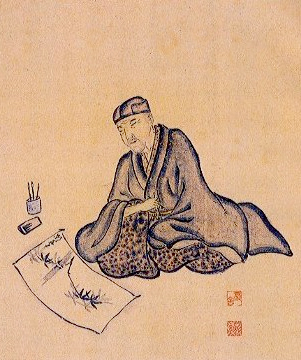Matsuo Bashō (1644 - 1694)
(from PoemHunter.com)

Matsuo Bashō (1644 - 1694)
adapted from The European Graduate School and PoemHunter.com websites
Bashō is one of the most celebrated Japanese poets. His reputation extends from Japan to include a nearly global recognition. He is considered to be the inventor and master of the haiku and his travel journals are the first examples of the haibun form (prose plus haiku). His work is praised for its brevity and clarity. Many monuments in Japan bear his poems. His works include Record of a Travel-Worn Satchel and Narrow Road to the Far North (Interior).
Bashō was born in Iga Province, close to the city of Ueno. He was name Matsuo Kinsaku. He began writing poetry when he was young. He quickly became a fixture amongst the intelligentsia of Edo period Japan. However, he rejected urban life and its literary circles. He was known to take to the countryside to wander in the wilderness. His experiences and observation of nature fueled his work. Stylistically, he sometimes rejected the strict stylistics of kigo then in favor for haiku. He felt he could reveal nature and emotion more directly. Thus he is given credit for developing the haiku as a free standing poem. Despite the fact that Bashō did not always work in the most popular style of poetry, he was widely admired in his lifetime. At the end of the nineteenth century, the Japanese interest in his work became a national obsession. His reputation was so inflated that Shinto bureaucrats labelled negative critiques of his poetry blasphemy. In the twentieth century, translations of Matsuo Bashō’s work into European languages expanded his influence. His writings would influence Imagist poets (including Ezra Pound) as well as the Beat Generation writers. His use of image has, perhaps, been duplicated but never rivaled.
Bashō’s father was probably a samurai, though not one of high reputation. If this is true, Bashō would have easily been embraced in the military. Yet when Bashō was still a child, he came to serve Todo Yoshitada. Yoshitada nurtured the boy’s literary and poetic interests, encouraging him to take part in the collaborative haikai no renga—a collaborative style of poetry from which the haiku was to be derived. In 1662, Bashō’s first poem was published. In 1664, Bashō’s first collection was released. In a later period, Bashō began to teach and he adopted the nom de plume Tosei. The work of his students would eventually be collected in The Best Poems of Tosei’s Twenty Disciples. Matsuo Basho’s reputation was so significant that the students wanted to promote their connection to the master. In 1680, Basho began to move away from the literary public. He relocated his home to Fukagawa. His students constructed a home for him and planted a banana tree for him. In honor of this event, he adopted the name Bashō, which means banana tree.
There he became a practitioner of Zen meditation. He entered a period of personal turmoil when in 1682 his house burnt down and in 1683 his mother died. He went to Yamura to live with a friend for a short while. His students rebuilt his home, but he could not shake his negative mindset. He soon undertook the first of his four major travel journeys. Such undertakings were dangerous because of the lawlessness of the period. Many anticipated that he would be murdered by highway men or (if lucky) simply expire in the wastes between cities. However, Bashō met many friendly people and found joy in the experiences of nature.
The first trip led him from Edo to Mount Fuji to Ueno and finally to Kyoto. Many poets he met claimed to be his devotees. The clamoured for his wisdom and advice about their poetry. His main advice was to ignore the literary fads of Edo, and to ignore even the work of his that the amateur poets had found in his recent publications. When Bashō returned to Edo in 1685, he embraced his role of instructor and began to hold poetry contests.
In 1688, Bashō returned to his reclusive ways. In 1689, he and his student Kawai Sora would travel through the northern provinces. This journey would be memorialized in The Narrow Road to the Far North, which was published in 1694.
In 1694, Bashō would travel one last time to Ueno, Kyoto and Osaka. Illness struck him. He died in the company of his students. The following is thought to be his death poem.
tabi ni yande / yume wa kareno wo / kake meguru
falling sick on a journey
my dream goes wandering
over a field of dried grass
Notes:
- Full text of Bashō's Narrow Road to the Deep North
- Bashō's Biography
- Ray Rasmussen's Commentary on Bashō's "Hiraizumi"
- Ray Rasmussen's Haibun modelled on Bashō's "Hiraizumi"
- Ray Rasmussen's Haiku Website